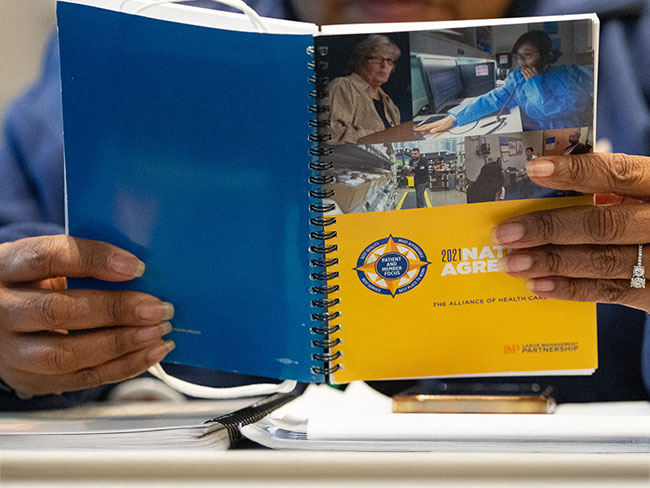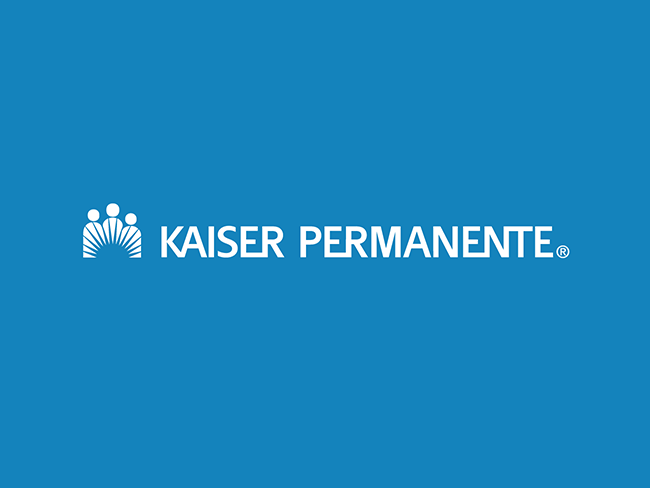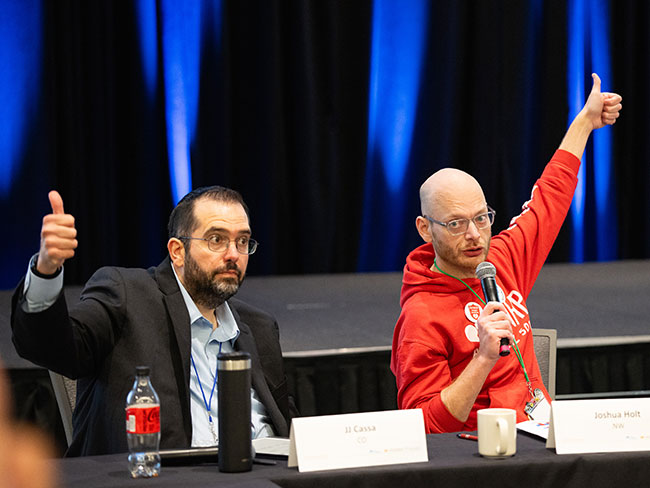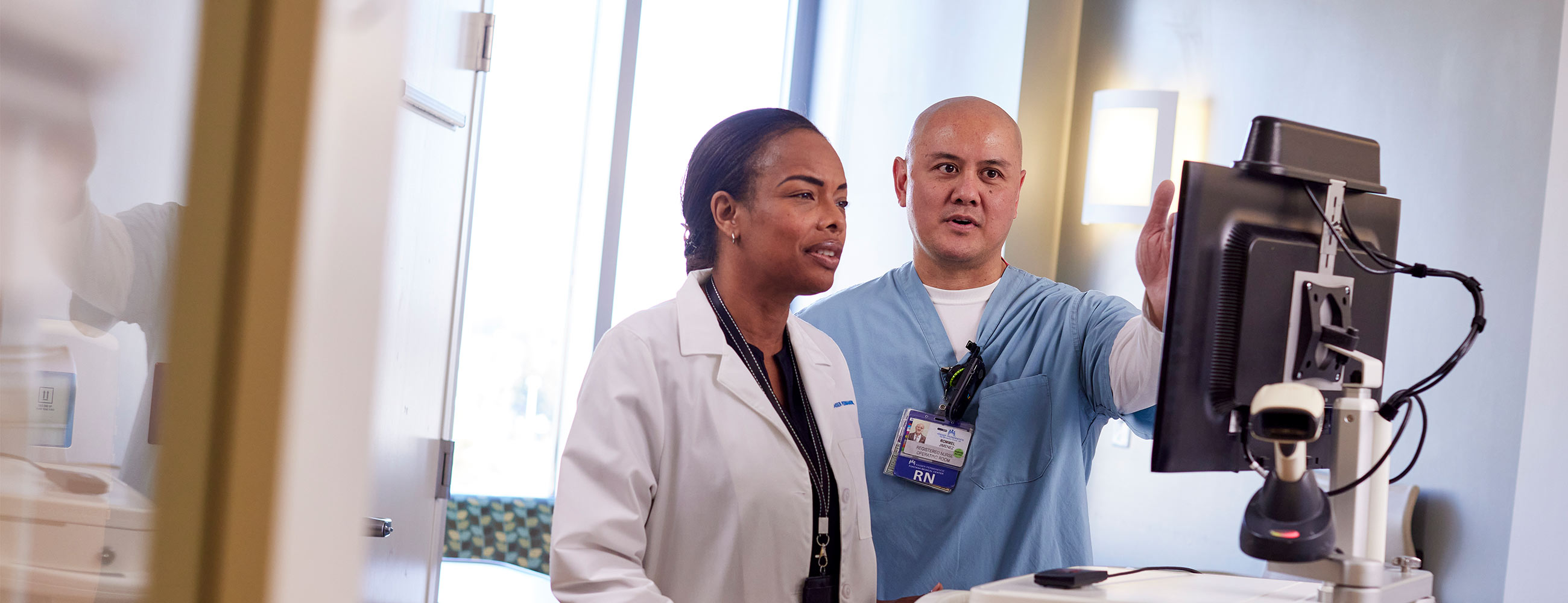Permanente embraces its partnership with labor
Henry J. Kaiser's legacy of labor relations continued after World War II through their support for the new health plan, creating lasting partnership opportunities.
Henry J. Kaiser and Sidney R. Garfield, MD, survey the site for the Walnut Creek Medical Center, completed in 1953
Throughout its history, Kaiser Permanente has relied on the “can-do spirit” of its dedicated workers and on the support of organized labor to keep the prepaid health plan strong.
Coming out of World War II, the medical plan had proven its viability in caring for a large shipyard workforce, but with the end of shipbuilding contracts, Henry Kaiser and Permanente founder and medical director Dr. Sidney Garfield had a big problem. Where were the large numbers of new members going to come from?
Kaiser, a friend of labor, attracted workers’ unions whose leaders understood the power of prepaid health care and wanted it for the welfare of their workers. Bay Area workers — from Oakland city employees, who were the first to sign up, to union typographers, street car drivers and carpenters — embraced the Permanente Health Plan with its emphasis on preventive medicine.
In 1950, Harry Bridges brought the 6,000-member International Longshoremen and Warehousemen Union (ILWU) into Kaiser Permanente, bringing the total West Coast membership, including Los Angeles, to almost 160,000. In 1951, the Retail Clerks union added 30,000 to the membership rolls in Los Angeles.
Opposition tries to squelch Kaiser Permanente
Despite this success, Kaiser and Garfield often faced rear guard actions from private practice doctors who felt threatened by group practice medicine. In 1953 when KP opened a new hospital in Walnut Creek and sought the health plan contract with workers in the U.S. Steel plant in Pittsburg, California, all hell broke loose in that small town along the Carquinez Strait.
Before Kaiser Permanente came along, the steelworkers union had both a national hospitalization plan and a local supplementary health plan with local private practice doctors. The workers were not satisfied with the current health plan and were complaining that providers charged too much and were lackadaisical about responding to emergencies and requests for house calls.
For their part, the Pittsburg area doctors argued that inflation required rates to rise and disputed the idea that service to members was lax.
Kaiser Permanente already provided care to steelworkers at the South San Francisco Bethlehem Steel plant and was prepared to expand services to the Pittsburg area. The beginning of KP’s negotiations with the Steelworkers Local 1440 in Pittsburg raised the hackles of the 41 private practice doctors already established in the area.
These doctors, all members of the East Contra Costa branch of the Alameda-Contra Costa Medical Association, quickly devised a new and better plan to offer the union, including 24-hour emergency service and a cap on fees.
Offer steelworkers couldn’t refuse
Joseph Garbarino, in his 1960 study of the Pittsburg conflict for the University of California, reported that the union bargainers welcomed Kaiser Permanente because of its offer to provide comprehensive care for a specific price for a specified period of time. This arrangement was attractive to the local union whose leadership had never before been able to negotiate such a favorable deal with their private practice providers.
-
Social Share
- Share Permanente Embraces Its Partnership With Labor on Pinterest
- Share Permanente Embraces Its Partnership With Labor on LinkedIn
- Share Permanente Embraces Its Partnership With Labor on Twitter
- Share Permanente Embraces Its Partnership With Labor on Facebook
- Print Permanente Embraces Its Partnership With Labor
- Email Permanente Embraces Its Partnership With Labor

December 26, 2025
Momentum at local tables
Here are the facts about progress at local bargaining.

December 18, 2025
Why we paused bargaining
We made the difficult decision to pause national bargaining with the Alliance …
December 17, 2025
Final session of 2025 concludes with one tentative agreement
Four additional bargaining dates set to kick off the new year.

December 14, 2025
Let’s close the deal
Historic 21.5% wage boost and enhanced benefits await. Watch this message …
December 10, 2025
A productive 22nd NUHW bargaining session
After a 3-week hiatus, 3 tentative agreements were reached.

December 5, 2025
Where we stand
New bargaining dates are set for December 11 to 15, as Alliance-represented …

November 20, 2025
It’s time to move forward
Our strong, historic offer honors Alliance-represented employees’ contributions …
November 18, 2025
Busy day at the bargaining table for Kaiser Permanente and NUHW
Several responses to proposals were shared in 21st bargaining session.
November 11, 2025
Kaiser Permanente and NUHW check in on outstanding proposals
Three responses were shared in the 20th bargaining session.
November 7, 2025
Kaiser Permanente and NUHW reach one tentative agreement
Additional sessions in December were confirmed.

November 7, 2025
Negotiations continue
Kaiser Permanente offers proposal that would provide for more employee …

November 4, 2025
Visualizing our offer
New online tool provides Alliance-represented employees a personalized …
October 31, 2025
Kaiser Permanente and NUHW continue negotiations
Four proposals were exchanged in 18th bargaining session.
October 28, 2025
2 tentative agreements reached in 17th session
Kaiser Permanente and NUHW continue making progress at the bargaining table.

October 24, 2025
Strong offer, stronger future
Kaiser Permanente’s economic proposal rewards Alliance-represented employees …

October 19, 2025
Kaiser Permanente returns to normal operations after strike
Bargaining for a new national contract with the Alliance of Health Care …
October 16, 2025
Bargaining continues during 16th session
Additional counterproposals exchanged between Kaiser Permanente and NUHW.

October 13, 2025
Our statement on the Alliance of Health Care Unions’ strike
We remain committed to an agreement that balances fair pay with affordable …

October 12, 2025
A strong offer that puts patients and employees first
We're committed to reaching an agreement that honors our employees, protects …
October 11, 2025
Another tentative agreement reached in bargaining
Additional counterproposals exchanged between Kaiser Permanente and NUHW.

October 10, 2025
Latest bargaining session fails to reach agreement
We are committed to negotiating a fair contract with the Alliance, despite …
October 6, 2025
Kaiser Permanente and NUHW exchange multiple proposals
Session marked by continued dialogue.

October 4, 2025
Despite strong offer on the table, strike notices received
Kaiser Permanente strengthens latest economic proposal offering competitive …
October 2, 2025
Key proposals reintroduced at NUHW bargaining
Kaiser Permanente and NUHW reach a tentative agreement on associate licensure …
September 30, 2025
Tailoring mental health care to the needs of our members
Recognizing that mental health is an essential part of overall well-being, …

September 29, 2025
Work continues to reach new national agreement
Kaiser Permanente and Alliance enter into third-party mediation to help …
September 26, 2025
Bargaining continues with meaningful exchange of proposals
Kaiser Permanente and the National Union of Healthcare Workers exchange …
September 24, 2025
Bargaining gains momentum with 2 new tentative agreements
Kaiser Permanente and the National Union of Healthcare Workers agree on …

September 24, 2025
A job at Kaiser Permanente is much more than a paycheck
Being a part of the country’s largest mission-driven health care organization …

September 24, 2025
See what makes our offer stand out
Higher pay and investments in your benefits and educational opportunities …
September 22, 2025
NUHW bargaining sessions provide robust exchanges
Kaiser Permanente and the National Union of Healthcare Workers discuss …

September 19, 2025
Understanding the value of a Kaiser Permanente job
Our proposal means higher pay and stronger benefits for you.
September 17, 2025
Progress continues in NUHW bargaining sessions
Kaiser Permanente and the National Union of Healthcare Workers exchange …

September 13, 2025
The value of a Kaiser Permanente job
Kaiser Permanente is proud to offer competitive pay, outstanding benefits, …

September 13, 2025
Update on Alliance national bargaining
Negotiations focus on pay, benefits, and remaining staffing proposals.

September 13, 2025
Details of our latest offer to the Alliance of Health Care Unions
Kaiser Permanente rewards employees for the excellent care they provide.
August 29, 2025
Negotiations focus on patient access, therapist support
Kaiser Permanente and NUHW continue to exchange and consider proposals.

August 28, 2025
We celebrate our employees this Labor Day
Kaiser Permanente has a long, proud history of working with unions.
August 26, 2025
Kaiser Permanente and NUHW bargaining update
Our proposals to the National Union of Healthcare Workers seek greater …

August 23, 2025
Alliance national bargaining update
New tentative agreements enhance the minimum wage and strengthen the Labor …
August 15, 2025
NUHW bargaining progresses
Discussions at the bargaining table focused on the job duties and workload …
August 13, 2025
Third tentative agreement reached
Kaiser Permanente and the National Union of Healthcare Workers continue …

August 7, 2025
Alliance national bargaining talks move forward
Kaiser Permanente and the Alliance reach 30 tentative agreements.
July 31, 2025
Second tentative agreement reached
Kaiser Permanente and the National Union of Healthcare Workers reached …
July 24, 2025
NUHW bargaining continues in Northern California
Kaiser Permanente and the National Union of Healthcare Workers reached …

July 17, 2025
National bargaining talks progress
Kaiser Permanente and Alliance of Health Care Unions navigate key issues. …

July 17, 2025
2025 Alliance national bargaining facts at a glance
July 11, 2025
NUHW bargaining update in Northern California
In a second bargaining session, Kaiser Permanente and the National Union …
July 8, 2025
NUHW bargaining begins in Northern California
First day of negotiations between Kaiser Permanente and the National Union …

July 8, 2025
Working together at the heart of health care
Organized labor is key to who we are, where we’ve been, and where we’re …

June 23, 2025
How Kaiser Permanente uses AI responsibly
To guide our use of AI, Kaiser Permanente has created a set of 7 responsible …

June 5, 2025
National bargaining progress continues
Kaiser Permanente and Alliance unions reach 4 tentative agreements and …

June 4, 2025
Frequently asked questions about bargaining
Here’s what you should know now that Alliance of Health Care Unions national …
May 8, 2025
New NUHW contract ratified
Kaiser Permanente Southern California and the National Union of Healthcare …

May 8, 2025
Interest-based problem solving: What it is, why it matters
During national bargaining, labor and management use this collaborative …

May 8, 2025
National Alliance bargaining begins
Kaiser Permanente and the Alliance of Health Care Unions kick off negotiations …

April 30, 2025
A history of trailblazing nurses
Nursing pioneers lay the foundation for the future of Kaiser Permanente …

April 16, 2025
Sidney R. Garfield, MD: Pioneer of modern health care
Kaiser Permanente’s co-founding physician spread prepaid care and the idea …

May 3, 2024
Henry J. Kaiser: America’s health care visionary
Kaiser was a major figure in the construction, engineering, and shipbuilding …

April 8, 2024
Martin Luther King Jr.’s dream is alive at Kaiser Permanente
Greg A. Adams, chair and chief executive officer of Kaiser Permanente, …

February 13, 2024
A legacy of life-changing community support and partnership
The Kaiser Permanente Watts Counseling and Learning Center started as a …

February 2, 2024
Expanding medical, social, and educational services in Watts
Kaiser Permanente opens medical offices and a new home for the Watts Counseling …

November 9, 2023
New 4-year agreement ratified
National agreement between Kaiser Permanente and the Coalition will help …

October 17, 2023
How Kaiser Permanente evolved
Sidney R. Garfield, MD, and Henry J. Kaiser came together to pioneer an …

September 13, 2023
Transforming the medical record
Kaiser Permanente’s adoption of disruptive technology in the 1970s sparked …

July 26, 2023
Kaiser Permanente hiring 10,000 new staff for Coalition jobs
More than 6,500 of these union-represented positions have already been …

May 2, 2023
Women lead an industrial revolution at the Kaiser Shipyards
Early women workers at the Kaiser shipyards diversified home front World …

April 25, 2023
Hannah Peters, MD, provides essential care to ‘Rosies’
When thousands of women industrial workers, often called “Rosies,” joined …

November 11, 2022
A history of leading the way
For over 75 innovative years, we have delivered high-quality and affordable …
November 11, 2022
Pioneers and groundbreakers
Learn about the trailblazers from Kaiser Permanente who shaped our legacy …
November 11, 2022
Our integrated care model
We’re different than other health plans, and that’s how we think health …
November 11, 2022
Our history
Kaiser Permanente’s groundbreaking integrated care model has evolved through …

October 21, 2022
Kaiser Permanente therapists ratify new contract
New 4-year agreement with NUHW will enable greater collaboration aimed …
October 14, 2022
Contact Heritage Resources
October 1, 2022
Innovation and research
Learn about our rich legacy of scientific research that spurred revolutionary …

May 26, 2022
Nurse practitioners: Historical advances in nursing
A doctor shortage in the late 1960s and an innovative partnership helped …

March 22, 2022
NUHW psych-social employees ratify agreement
The agreement between Kaiser Permanente and the NUHW in Southern California …

September 10, 2021
‘Baby in the drawer’ helped turn the tide for breastfeeding
This innovation in rooming-in allowed newborns to stay close to mothers …

August 25, 2021
Kaiser Permanente’s history of nondiscrimination
Our principles of diversity and our inclusive care began during World War …

July 22, 2021
A long history of equity for workers with disabilities
In Henry J. Kaiser’s shipyards, workers were judged by their abilities, …

June 2, 2021
Path to employment: Black workers in Kaiser shipyards
Kaiser Permanente, Henry J. Kaiser’s sole remaining institutional legacy, …

February 22, 2021
The Permanente Richmond Field Hospital
Forlorn and all but forgotten, it played a proud role during the World …

September 28, 2020
A legacy of disruptive innovation
Proceeds from a new book detailing the history of the Kaiser Foundation …

August 26, 2020
Kaiser Permanente’s pioneering nurse-midwives
The 1970s nurse-midwife movement transformed delivery practices.

July 30, 2020
Books and publications about our history
Interested in learning more about the history of Kaiser Permanente and …

May 18, 2020
Nurses step up in crises
Kaiser Permanente nurses have been saving lives on the front lines since …

November 8, 2019
Swords into stethoscopes — veterans in health professions
Kaiser Permanente has actively hired veterans in all capacities since World …

August 28, 2019
When labor and management work side by side
From war-era labor-management committees to today’s unit-based teams, cooperation …

August 2, 2019
Thriving with 1960s-launched KFOG radio
Kaiser Broadcasting radio connected listeners, while TV stations brought …

June 5, 2019
Breaking LGBT barriers for Kaiser Permanente employees
“We managed to ultimately break through that barrier.” — Kaiser Permanente …

March 29, 2019
Equal pay for equal work
Kaiser shipyards in Oregon hired the first 2 female welders at equal pay …

February 5, 2019
Mobile clinics: 'Health on wheels'
Kaiser Permanente mobile health vehicles brought care to people, closing …

December 10, 2018
Southern comfort — Dr. Gaston and The Southeast Permanente Medical Group
Local Atlanta physicians built community relationships to start Kaiser …

May 30, 2018
John Graham Smillie, MD, pediatrician and innovator
Celebrating the life of a pioneering pediatrician who inspired the baby …

April 30, 2018
Nursing pioneers leads to a legacy of leadership
Kaiser Foundation School of Nursing students learned a new philosophy emphasizing …

April 19, 2018
Wasting nothing: Recycling then and now
Environmentalism was a common practice at the Kaiser shipyards long before …

April 12, 2018
Harold Hatch, health insurance visionary
The founding of Kaiser Permanente's concept of prepaid health care in the …

March 26, 2018
5 physicians who made a difference
Meet 5 outstanding doctors who advanced the practice of medical care with …

March 13, 2018
Henry J. Kaiser and the new economics of medical care
Kaiser Permanente’s co-founder talks about the importance of building hospitals …

March 8, 2018
Slacks, not slackers — women’s role in winning World War II
Women who worked in the Kaiser shipyards helped lay the groundwork for …
